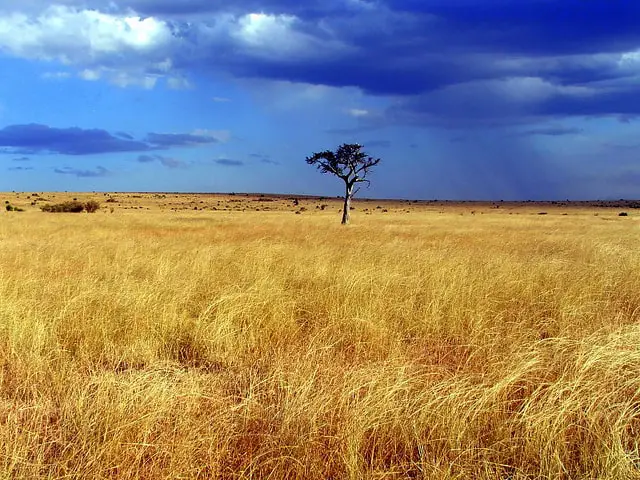Table of Contents
*This post may contain affiliate links. As an Amazon Associate we earn from qualifying purchases.
Meta Description: The Masai Mara National Reserve offers a rich diversity of plant and animal life. Whether you choose to traverse the area in a rugged, safari vehicle or a wafting, hot air balloon, you will have a unique point of view and unforgettable experience during the dry season in Kenya, Africa.
Stock Image: https://depositphotos.com/search/masai-mara.html?qview=111303226
Things You Should Know About Visiting Masai Mara Game Reserve
Masai Mara National Reserve is located in Kenya, Africa and is home to thousands of species of birds, mammals and reptiles. It was named for the ancestral Masai people who still inhabit the area. These semi-nomadic groups have kept their distinctive stretched earlobes, colorful tribal dress and customs, and are happy to greet any travelers they meet as they cross through parts of the park.
The Reserve covers nearly 600 square miles and runs along the northern boundaries of the Serengeti. The Sand River, the Talek River and the Mara River run through the Reserve. Although it is located on a plain, there are small hills throughout the area, and the landscape is dotted (that is the meaning of “Mara”) with patches of trees and shrubs. Tourism has grown in the last ten years, making it one of Africa’s most popular safari locations.
Best Time To Visit
Visiting when the weather is moderate, and animal migrations are at peak will offer a satisfying safari experience, so plan your visit to Masai Mara Game Reserve sometime between June and October. This is known as the dry season.
Vegetation has either been eaten or has begun to die off to due to lack of life-giving rain, so it is easier to see the wildlife in the area. Less moisture also means fewer mosquitos and insect pests. However, it is recommended that you use plenty of bug spray.
The coolest months fall between those times as well, peaking from June through August when the average highs reach around 77º F. The nights are a cool and comfortable 50º F. During the dry season, tourists are very likely to see a good deal of wildebeest and other animals as they migrate through on their way to the Serengeti in Tanzania.
Access
There are six different airports, by which traveler may reach the area. Within Masai Mara Reserve area itself are the Musiara Airport, Mara Serena Airport, and Keekorok Airport. The conservation area of the Reserve is home to Kichwa Tembo Airport, Ngerende Airport and Mara Shikar Airport.
Although there is only one lodge within the Masai Mara Triangle, there are some within the Reserve. Keekorok has a popular lodge, and in the Masai town of Narok, on the west side of the Reserve, there are also several camps and lodges where travelers to Masai Mara might stay when visiting.
In Narok, there are shops where native Masai people sell their arts and crafts and ethnic foods. Travelers should be aware that unless they have signed up for a tour with an agency that includes the safari and housing, they would need to make arrangements themselves.
The roads throughout the park are well maintained for those who wish to take a safari. Tourists are not allowed to drive themselves though, and there is a strict rule as to the number of cars allowed at any one time, in order to protect the wildlife as well as the people viewing it. For those who wish a different point of view, hot air balloon safaris are also available.
Although the landscape is unique and the food in Kenya is colorful and interesting, most people are all about the safari experience. A rich diversity of animals live in the Masai Mara National Reserve.
Reptiles and Amphibians
The list of reptiles and amphibians found in the Masai Mara National Reserve is extensive. Leopard tortoise and the helmeted terrapin are among the most benign of the species living in the Reserve. A large variety of toads and frogs also live here, of which only the red-banded rubber frog is known to be harmful to humans.
Others include the Mascarene rocket frog, marbled snout burrower, northern foam-nest frog and the guttural toad. If those aren’t enough, there is the striped leaf-folding frog, Boettger’s dainty frog and the sharp-nosed reed frog. These species are not likely to be seen, but you will definitely hear them in the late evenings and throughout the night as their croaking fills the air.
Of course, the star of the Reptile family is the crocodile. These primitive beasts weigh in at around 500 pounds when they reach adulthood, and they grow to between 16 and 20 feet in length. They have the strongest bite of any animal, and although their diet primarily consists of fish, they do not hesitate to treat themselves to a zebra, wildebeest or antelope for a snack, killing thousands of these animals during the seasonal migrations.
Lizards and Snakes
Most of the lizards are harmless, including the tropical house gecko, Nyika gecko, and the Afro-tropical ground gecko. But snakes may be one of the scarier of the African wildlife because of their silent approach.
Always watch your step. Never assume what you see lying on the ground or hanging from the branch of a tree is a stick or vine. The Mara is known to have the black-necked spitting cobra, black mamba, velvety green night adder, puff adder, gaboon viper and at least four others. If snakes are your thing, be sure to ask about Kenya’s Big 5 Snake Safari.
Birds and Mammals
You may not see as many birds as you will hear. From the time the sun comes up until it sets again, birdsongs may be heard all around the grounds. There are more than 470 species of birds from the tall to the small that can be found in the National Reserve.
Birds include multiple varieties of the following species: swallows and martins; larks and sparrows; woodpeckers and wrynecks; honeyguides, barbets and tinkerbirds; hornbills, hoopoes and woodhoopoes; rollers, bee-eaters, kingfishers, trogons, mousebirds, and swifts; nightjars, owls, cuckoos and coucals, turacos, parrots; terns and sandpipers; plovers, lapwings and snipe; coursers, jacanas and stilts, cranes and bustards; rails, crakes, moorhens and coots; quails, buttonquails, francolins and guineafowl; falcons and kestrels; eagles, kites, harriers, hawks and relatives; vultures; ibis and spoonbill; hamerkop, grebes and shoebill; storks; herons, egrets and bitterns; pelicans, cormorants and darters.
The most watched-for bird is the Common Ostrich. This 6 to 9-foot tall wonder weighs in at between 140 to 320 pounds, depending on height. They run in a flock (some people call them herds due to their size) of anywhere between ten to 100 individuals and are plentiful, so they are likely to be seen.
Smaller mammals that stay more in the bush areas out of sight include the striped polecat and the honey badger. Lesser bushbabies, as well as the blue monkey, red-tailed monkey, vervet monkey and the olive baboon, may only occasionally be seen, but you may frequently hear their whoops from a distance.
There is no shortage of big game mammals in Masai Mara Game Reserve. The long-horned African buffalo are plentiful, as well as thousands of Thompson’s gazelles, common elands, impalas, and reedbucks that wander in the Mara. Thousands of zebras and thousands upon thousands of wildebeest (gnus) cross the Mara River in search of fresh drinking water, constantly on the alert against the voracious appetite of the crocodiles, which reside there.
Other predators are found throughout the Reserve. Lions are on the prowl, and this is the time of year they are teaching their young to hunt. A favorite place is again, the Mara River. As animals come up the near bank, exhausted from crossing the river and fighting the grasp of the crocodiles’ jaws, they become easy prey to lions and hyenas, especially the new calves.
The black-backed jackal, bat-eared fox and the spotted hyena are always on the hunt for a meal, so they tend to follow herds were young are found and prefer to do their hunting at night, as do the caracal, serval, leopards and cheetahs that can quickly and quietly pick off an animal for a meal.
Although giraffe populations in Masai Mara National Reserve are down by an alarming 95 percent due to human settlements that surround the Reserve, if you cover enough territory on your safari you will probably see one.
Warthogs also make their home here, as do hartebeest, topi antelope and waterbuck. If you are lucky, you may catch a rare glance of a black rhinoceros. There are no white rhinos in the Masai Mara Reserve. The hippopotamus is a more common sight, especially along the Mara River.
And of course, no safari would be complete without a glimpse of the big daddy of wild game, the elephant. Elephants form emotional family bonds and live in family herds of anywhere from eight to 100 individuals, led by the oldest female. These herds are called matriarchs.
Although elephant numbers had diminished over the past three decades, they have seen a resurgence over the last three years. It is estimated that there are 30,000 to 38,000 of these 24-foot tall, ten-ton pachyderms roaming the Reserve, so you have a good likelihood of spotting at least a few.
Masai Mara tourism is alive and well in the Reserve. The wildlife is abundant, and the scenery is varied and beautiful. Whether by land vehicle or by hot air balloon, unforgettable sights, smells and tastes await those who venture to visit this African treasure.

